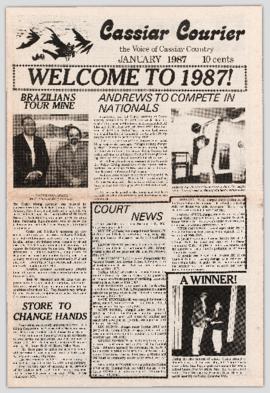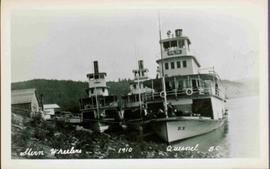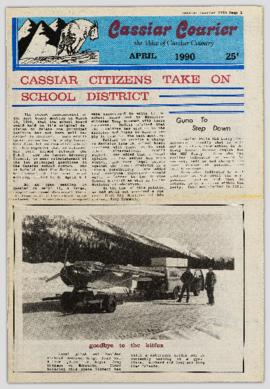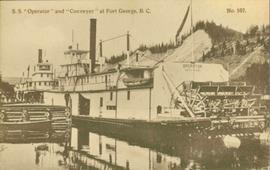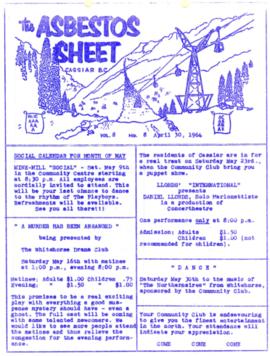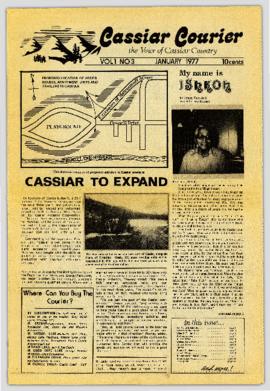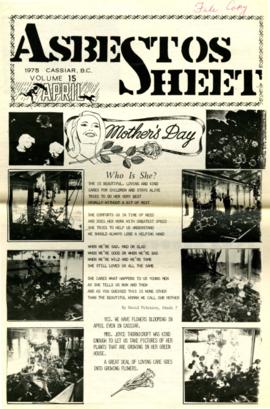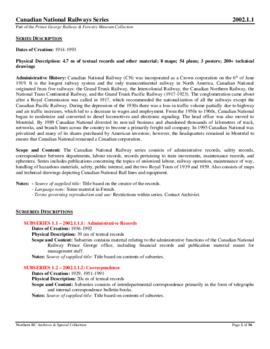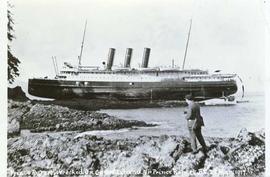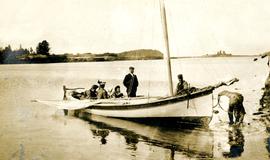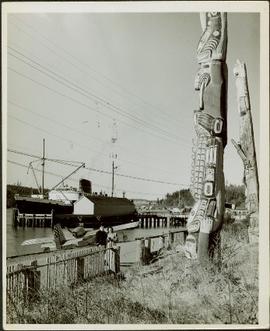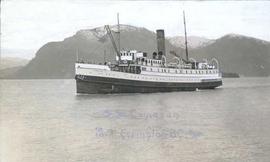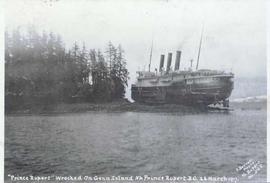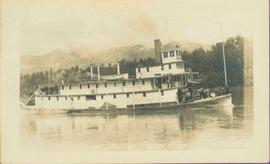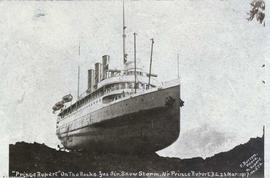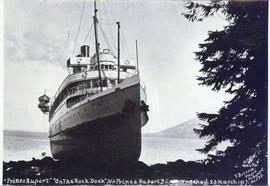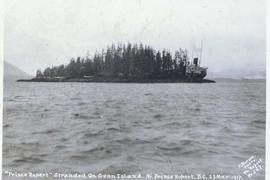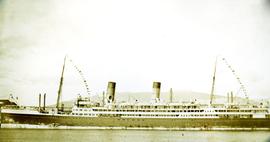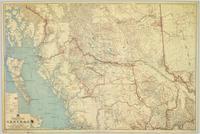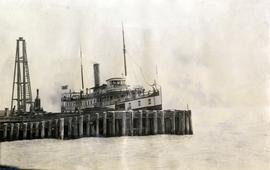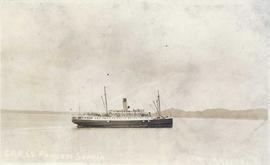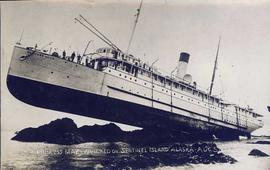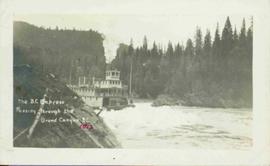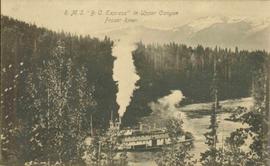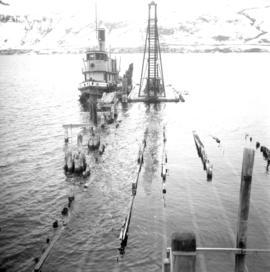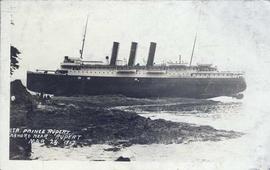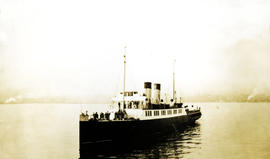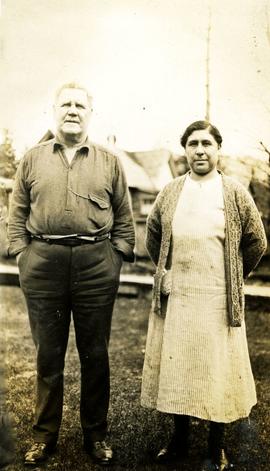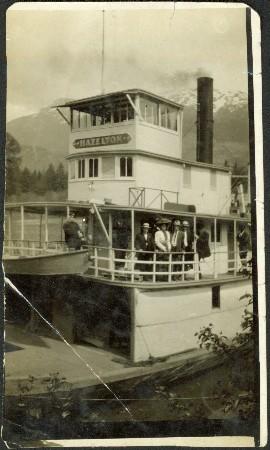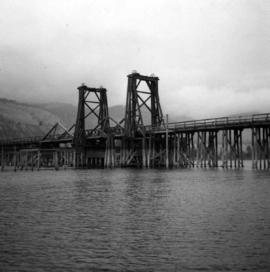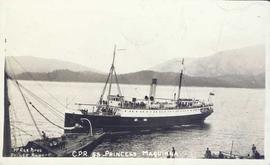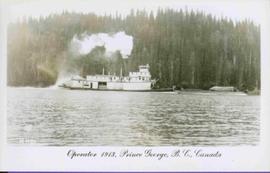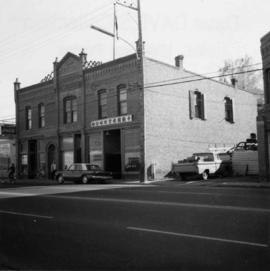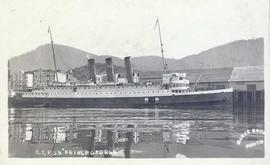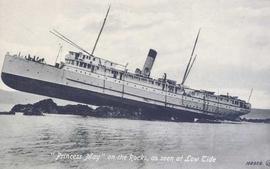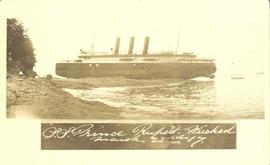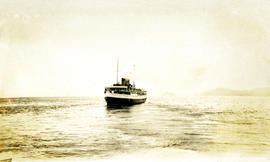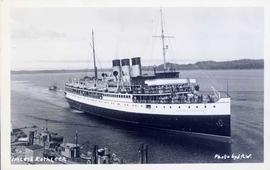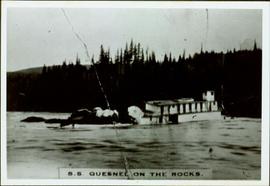File consists of general correspondence concerning various administrative issues and the transfer of the Aleza Lake Experiment Station, newspaper articles, memoranda containing the general history of the Experiment Station, diagrams of timber sales, 1927 logging inspection reports, and an envelope containing biographical sketches of individuals involved in the early history of the Experiment Station.
File consists of the following articles and speeches written by Knox McCusker:
- "Reminiscences of Knox McCusker" (63 typewritten pages)
- "Back and Beyond the Peace" by K.McCusker (taken from the Toronto Star Weekly Saturday May 5, 1928) – retyped
- "The Alaska Highway" by Knox F. McCusker, D.L.S. (The Canadian Surveyor, July 1943)-photocopy
- Mr. McCusker's speech (5 pages)
- “Tropical Valleys of B.C.” (4 pages)
- "The president has called me an old old surveyor…" speech written by K. McCusker
- "In the early days of my career in the Surveying profession…" written by K. McCusker
"The Cassiar Courier" is a newspaper that documents the community and work life of the residents of Cassiar BC. Content includes text and photographs, as well as jokes, comics, and games.
Photograph features three sternwheelers tied to river bank. Buildings visible on far left, hills on shore visible in background.
Printed annotation on recto reads: “Stern Wheelers 1910 Quesnel B.C.” Handwritten annotation on verso in pencil reads: “BX, B.C. Express, Charlotte”
"The Cassiar Courier" is a newspaper that documents the community and work life of the residents of Cassiar BC. Content includes text and photographs, as well as jokes, comics, and games.
Audio recording consists of individual taped interviews conducted by Bridget Moran with a number of early Fort George residents recalling the early years of white settlement in Prince George c.1910-c.1915. Interviews were conducted with the following individuals: Arnold Davis; J.A.F. Campbell; Alec Moffat; Claude Foot; George Henry; Nellie Law; John McInnis; Georgina [McInnis] Williams and Peter Wilson. These interviews were incorporated into the publication: Bridget Moran, Prince George Remembered…from Bridget Moran, Marsh Publishing, Prince George, 1996.
Audiocassette Summary
Scope and Content:Recording consists of individual taped interviews conducted by Bridget Moran in a number of locations with Arnold Davis; J.A.F. Campbell; Alec Moffat; Claude Foot; George Henry; Nellie Law; John McInnis; Georgina [McInnis] Williams; Peter Wilson
Subjects include:
- Arnold Davis – former Sherriff in Prince George (born in 1882) arrived in Quesnel in 1909 and worked on the BX sternwheeler. Davis discusses his family roots from Ireland as a 6th generation Canadian. Recalls how his family arrived in South Fort George in 1917 and how his father worked on boats that went up and down Fraser River
- Claude Foot recalls coming from New Zealand to Fort George [Prince George] in 1906 and how there were ‘very few white men’; his father was Irish, mother was English
- Alex Moffat – describes how his parents provided a ‘stopping place’ for stage coaches in the Cariboo region
- George Henry recalls working on the boats that plied the Fraser River between Prince George and Soda Creek, near Quesnel
- Nellie Law – describes arriving from England in 1917 to Ashcroft and then Quesnel in 1917
- Peter Wilson – Barrister and Solicitor; the prosecutor for Prince George since 1916 describes arriving by train from Edmonton and arriving on a scow in South Fort George
- Mr. John McInnis – from Prince Edward Island, who sat twice in provincial legislature – in constituency of Grand Forks as socialist and later for constituency of Fort George recalls arriving in 1910 by rail to Kamloops and then by sleigh to South Fort George; describes the Indian Reserve at Fort George “[…don’t think there were a dozen white people…when I arrived […]”
- J.A. ‘Doc’ Campbell recalls being part of a survey crew in Fort George in 1908
- George Henry – also recalls cruising down the [Fraser] river by way of sternwheeler and losing men overboard
- Peter Wilson recalls experiences as practicing lawyer; there was no assize court in the region until 1919; recalls some of his early cases [murder case]
- Nellie Law describes working as a desk clerk at first The Alexandra Hotel and later The Prince George Hotel from 1918 to 1952
Law describes the hotel patrons and how she met the Duke and Duchess of Devonshire in 1922. Recalls stoking furnace with logs in the hotel to keep it warm and working as a bouncer - Alex Moffat – recalls workers and hauling freight via the old Cariboo Road; existence of one policeman only (BC Provincial Police); and describes in detail a stopping place for horses / crew on the Cariboo Road and the pack trains.
- Mr. Moffat – Describes the luxury experienced on the sternwheeler, The BX that “could carry seventy saloon passengers” and “staterooms were all equipped with push buttons, electric lights, hot and cold water, steam heat, and everything modern”
- Claude Foot – Recounts a dance in Quesnel at the hotel barroom and describes ordering drinks at the Al Johnson Hotel that had a bar which boasted to be “ the biggest bar in Canada, if not the world” 100 ft + bar with “six or seven bartenders behind this long bar, and the customers would be lined up two or three deep […]”
- J.A. [F.] [Campbell] – post-1910 changes with the use of scows on the Fraser River; describes the BC Provincial Police “in those days [they] just wore ordinary civilian clothes, but they were a tough bunch….[…]” and rowdiness in the bars in South Fort George
- Campbell describes the first bank in Fort George was the Bank of British North America that was housed in a tent and he recalls needing money while playing poker - ‘about eleven o’clock that night, the vault was open, and the till was open, and if you wanted money you’d walk up to the bank till and put an IOU in and take money out and go on playing [poker]
- Peter Wilson – comments about how lax the enforcement of law and order was in the early years including among the police themselves: “that the “Old Blind Nick [who] ran a bootlegging joint, went broke because he said he couldn’t afford to supply the police with any more liquor.”
- Claude Foot – recalls a fire in Quesnel in 1916 that burned a large part of the business section and the firemen were as Nellie Law notes “ a bucket brigade of Chinamen, filling buckets from a water hole in the Fraser River that the horses drank in…”
- John McInnis recalls political meetings and the election in 1916 when he was a candidate for the Fort George riding and being defeated by 7 votes; that the investigation of the election “was a whitewash”
- Georgina McInnis, who was the first White Child born in the community – she tells of the meeting that decided her name – as Fort Georgina McInnis
- Arnold Davis recalls his father working on boats that went up and down Fraser River and being on the boat with him and “watching the connecting rods go in and out and concentrate on pie…[served by the Chinese cook]” Davis also recalls The Yukoners who emigrated to PG after the Gold Rush
- George Henry recalls with lament the coming of the railway as he lost his job plying the River - preferred voyages on the Fraser River – and refers to those who worked the River and himself as “river rats”
Postcard photograph depicts two sternwheelers in dock. Group of men can be seen standing on dock. Steep banks of opposite shore visible in background.
Printed annotation on recto reads: “S.S. “Operator” and “Conveyer” at Fort George, B.C. No. 107.”
"The Asbestos Sheet" is a newspaper that documents the community and work life of the residents of Cassiar BC. Content includes text and photographs, as well as jokes, comics, and games.
"The Cassiar Courier" is a newspaper that documents the community and work life of the residents of Cassiar BC. Content includes text and photographs, as well as jokes, comics, and games.
"The Asbestos Sheet" is a newspaper that documents the community and work life of the residents of Cassiar BC. Content includes text and photographs, as well as jokes, comics, and games.
File consists of documents relating to the construction of the Pacific Great Eastern Railway (PGE), which predominantly consist of photocopy reproductions, excerpts from books, and clippings from periodicals. Includes a chronology of the history of PGE, a list of sub-contractors who completed the Squamish sub-division, "PGE/BCR: Dease Lake Extension First 25 Years, 1968 to 1993", and "P.G.E.R. 1914 to 1923: Progressive Dates of Commencement of Passenger Service".
File consists of notes, clippings, and reproductions relating to the Cariboo and Northwest Digest publication. Also includes a CD-R that contains Sedgwick's index spreadsheet and accompanying documentation about the publication.
The Canadian National Railway series consists of administrative records, safety records, correspondence between departments, labour records, records pertaining to train movements, maintenance records, and ephemera. Includes publications concerning the topics of unionized labour, railway operation, maintenance of way, handling of hazardous materials, safety, public interest, and the two Royal Tours of 1939 and 1959. Also consists of maps and technical drawings depicting Canadian National Rail lines and equipment.
Canadian National RailwayThis document is an unpublished draft manuscript of a Northern British Columbia history annotated bibliography. The document is based overwhelmingly on research into secondary sources published prior to 2016; more recent sources are not included. The annotated bibliography includes the following sections:
- Historiography
- Settlement Histories
- Alexander Begg's History of British Columbia
- R.E. Gosnell
- E.O.S. Scholefield
- Regional History
- New Histories
- Environment
- Northern History
- Ancient History
- Bibliography
Photograph depicts a man standing in front of the steamship Prince Rupert run aground on a rocky shoreline. Annotation on recto of photograph states: "Prince Rupert" Wrecked On Genn Island Nr Prince Rupert B.C. 23 Mar' 1917. F. Button. Photo Pr Rupert No. 573" Annotation on verso of photograph states: "Dear Ted.- I am just writing you a note to remind you you have not written me since the last time. This is the way the Rupert is now she sure looks fine. I had a fine time in Rupert during the holidays. I wish you would send me some stamps. I traded Willie quite a few and two dandy, Montenegro ones. I am using my fountain pen now, it writes fine. I guess I will close your loving brother Gordon"
Audio recording is of an interview by Bridget Moran with both Mr. George Henry and Mr. Arnold Davis to discuss their memories of the early town site development of South Fort George and Central Fort George c.1910-c.1917. Mr. Henry was born in 1882 and his family arrived in Quesnel in 1909. Mr. Henry’s interview is primarily about his work as a captain on the BX Sternwheeler up until the time of the railroad arriving in Prince George in 1914. Mr. Davis, who was a Sherriff in Prince George, recalls his childhood memories of Fort George and Central Fort George c.1917. Mr. Davis also discusses his family roots from Ireland, the family’s arrival in Fort George from Ashcroft in 1917 and memories of his father who worked on the sternwheelers on the Fraser River.
Audiocassette Summary
Scope and Content:
Interview with Mr. George Henry
Mr. Henry was born in 1882 in Northern California and his family came to the Cariboo in 1909. He recalls riding his bicycle from Ashcroft to Quesnel in 3 days to find work with the BC Express Company.
Mr. Henry recalls working on the BX and describes the sternwheeler trip from Quesnel to South Fort George; it was a 3 hour trip from Quesnel and included two mail stops ;
Henry recalls an accident onboard the sternwheeler going through the Fraser Canyon (see p.p.11-12 of
Prince George Remembered)
Mr. Henry describes his homestead at South Fort George
Mr. Henry describes the BX sternwheeler being aground at South Fort George c.1920
Mr. Henry recalls spending winters in South Fort George in his log cabin; that work was “plentiful” in 1910 and the population at “about 700”
Mr. Henry notes that the “Indian reserve was at the Hudson’s Bay company” and that the native population was at “about 50”
Mr. Henry recalls the early commercial businesses in South Fort George c.1910 including the Northern Hotel; the candy store and ice cream store and theatre.
Mr. Henry describes the start of the town site of Central Fort George as a “viable little town” which started once the Grand Trunk Railway arrived and recalls the change in population between South Fort George & Central Fort George.
Henry recalls how all the workers came and lived in tents in Central Fort George.
Mr. Henry was not happy about the arrival of the railway as it meant he lost his job on the sternwheeler – he recalls that “us old river rats were just lost” (see p.p.34 of Prince George Remembered)
Bridget then asks Mr. Arnold Davis to recall his memories of early South Fort George
But first asks him to describe his family’s roots (See p.p. 1-2 of Prince George Remembered)
Scope and Content:
Interview with Mr. Arnold Davis
Davis notes he is 6th generation Canadian; family came from Ireland and his grandfather’s brother Jeff Davis became the President of the Confederate States of America.
Davis refers to his mother’s family being on the Prairies at time of the trial of Louis Riel
Davis explains that his grandfather first homesteaded at Banff; then Kamloops; then Ashcroft and on to South Fort George in 1917.
Davis’ father worked for the BC Express Company and he recalls being on the sternwheeler as a child during same time that George Henry worked the boats. Recalls workers on the boat; eating pie on the boat baked by the Chinese cook; (See p. 33 of Prince George Remembered)
Davis recalls the town site of South Fort George. He notes it had a population by 1917 of only “about 300” and that the “boom was over”
Davis describes location of various businesses in South Fort George including the Rex Theatre, George St. Poole Room, McKay Bros. Grocery store, Drugstore, Bairds, Peters Butcher Shop.
Davis recalls that there were many “Yukoners” here at the time and recalls a tale about an old Yukoner
Mr. Davis recalls other people who worked on the BX with his father including Margaret “Granny” Seymour’s father;
Mr. Davis recalls riding up and down the river to Foley’s Cache on the sternwheeler as a child
Mr. Henry then speaks up and recalls trips on the sternwheeler with Arnold Davis on the boat as a child
Tape ends
Rev. William Edwin Collison stands in centre of boat, with wife Bertha and daughters Muriel and Katherine seated behind. Unknown man and woman are also seated in boat, and an unknown man stands on shore holding rope.
Handwritten annotation on verso reads: "Will Collison with wife & children leaving Metlakatla to catch steamship en route to England (1910)".
Photograph depicts a man in uniform and a woman posing for a photo on a road situated between a fenced area featuring totem poles. Along the water’s edge in the background there is a float plane, wharf and the Camosun vessel. Handwritten annotation on verso reads: “Alert Bay B.C. Union Steamships Ltd.”; “Alert Bay BC”; photographer’s stamp on verso states: “W.E. Nicholson, 268 E. 10th, Vancouver 10, B.C.”
Photograph depicts the steamship Camosun on the water with a mountain range in the background. Annotation on recto of photograph states: "S.S. Camosun Port Essington B.C." Annotation on verso of photograph states: "Canada B.C. The Coast Steamer "Camosun" passing Port Essington"
Photograph depicts the steamship Prince Rupert run aground on a rocky shoreline beside a forested area. Annotation on recto of photograph states: ""Prince Rupert" Wrecked On Genn Island Nr Prince Rupert B.C. 23 March 1917. F. Button Photo Pr. Rupert No.568"
Postcard photograph depicts sternwheeler, men visible on deck, hills on opposite shore in background.
Printed annotation on recto reads: “B.C. Express Steamer, Fraser River.” Handwritten annotation in pencil on verso reads: “BC Express Fraser River BC”.
Photograph depicts the steamship Prince Rupert run aground on a rocky shoreline. Annotation on recto of photograph states: ""Prince Rupert" On The Rocks. Yes Sir. Snow Storm. Near Prince Rupert, B.C. 23 Mar: 1917. F. Button Photo. Pr. Rupert. No. 576"
Photograph depicts the steamship Prince Rupert run aground on a rocky shoreline with a tree in the foreground. Annotation on recto of photograph states: ""Prince Rupert" "On The Rock Dock" Nr Prince Rupert B.C. Wrecked 23 March 1917. F. Button Photo Pr. Rupert no.575."
Photograph depicts the forested Genn Island with the steamship Prince Rupert run aground on the rocky shore of the island. Annotation on recto of photograph states: ""Prince Rupert" Stranded On Genn Island. Nr. Prince Rupert. B.C. 23 Mar: 1917. F. Button. Photo Pr. Rupert. No 567."
Photograph depicts the MV Aorangi. This passenger vessel was built by Fairfield Shipbuilding and Engineering Company for the Union Steamship Company of New Zealand and launched in 1924 for the Vancouver-Australia passenger route. Handwritten annotation below photograph reads, "motor driven ship Aorangi".
Topographic map depicts communities, bodies of water, transport routes, parks, game reserves, posts, ports, radio stations, power sites (figures in horse power), steamship routes (distance in nautical miles), and precipitation. Mineral resources summarized locally in red ink.
Photograph depicts the "MV Ballena" docked at a wharf. The Ballena was a passenger ferry built in 1892 by the Albion Iron Works Company of Victoria and originally named the Joan. This ship was sold to the Terminal Steam Navigation Company in 1914 and renamed the Ballena. It was later acquired by the Union Steamship Company in 1920 but burned at the Union dock in November of that year.
Photograph depicts the steamship Princess Sophia on the water with a forested shoreline in the background. Annotation on recto of photograph states: "C.P.R. S.S. Princess Sophia Prince Rupert" Annotation on verso of photograph states: "Port Simpson B.C. J.M. Parger(?)"
Photograph depicts the steamship Princess May run aground on the rocky shoreline of Sentinel Island. Annotation on recto of photograph states: "PRINCESS MAY - WRECKED ON SENTINEL ISLAND ALASKA - AUG. 5 1910"
Photograph depicts sternwheeler passing through rapids of the Fraser River, B.C. Printed annotation on recto reads: “The B.C. Express Passing through the Grand Canyon B.C.”, handwritten in red ink: “1913”.
Postcard photograph depicts lofty view of sternwheeler in river, snow capped mountains in background.
Printed annotation on recto reads: “R.M.S. B.C. Express in Upper Canyon Fraser River.”
Photograph depicts a former sternwheeler building and repair slipway as well as a steam tug called the "Naramata." Steamer passengers ceased at the location in 1935 and rail service to the "Landing" in 1940.
Photograph depicts the steamship Prince Rupert after being run aground on a rocky shoreline. Annotation on recto of photograph states: "STR. PRINCE RUPERT ASHORE NEAR RUPERT MAR 23. 1917."
Photograph depicts the Canadian Pacific Railway turbine steamship S.S. "Princess Patricia". There is a faint view of the coastline in the distance. Handwritten annotation below photograph reads, "Princess Patricia".
Photograph depicts a male and female crewmember standing side by side. Crew members are possibly from the Union Steamship S.S. Camosun. Handwritten annotation below photograph reads, "Some of the Crew".
Photograph depicts a woman standing among men aboard a sternwheeler with the word "HAZELTON" above its deck. A man speculated to be the captain stands on deck to the left. Tree branches in foreground, opposite shore and mountains in background.
Photograph depicts an old wooden lifting span bridge (now rigid) over the east Thompson River at Pritchard, 25 miles east of Kamloops. View is looking northeast. The bridge was built for sternwheeler traffic.
Photograph depicts the steamship S.S. Princess Maquinna on the water with the stern of another ship in the foreground and a forested mountain range in the background. Annotation on recto of photograph states: "McRae Bros Prince Rupert C.P.R. S.S. PRINCESS MAQUINNA"
Postcard photograph depicts sternwheeler in river, trees on opposite shore in background.
Printed annotation on recto reads: “Operator 1913, Prince George, B.C. Canada”, handwritten in pencil on verso: “Operator 1913”.
Photograph depicts one of the earlier brick buildings beside the river, sited opposite the sternwheeler landing pier. It is called Commercial Block and was built in 1897.
Photograph depicts the steamship Prince George docked on the water with buildings in the background. Annotation on recto of photograph states: "G.T.P. S.S. "Prince George"
Photograph depicts the steamship Princess May run aground on rocks at low tide. Annotation on recto of photograph states: ""Princess May" on the Rocks, as seen at Low Tide"
Photograph depicts the steamship Prince Rupert run aground on a rocky shoreline. Annotation on recto of photograph states: "S.S. Prince Rupert Wrecked March 23rd 17."
Photograph depicts a steamship, Princess Kathleen in open water. Handwritten annotation below photograph reads, "Princess Kathleen in Rupert. 26/6/28".
Photograph depicts the steamship Princess Kathleen on the water with tugboats in the foreground and a forested shoreline in the background. Annotation on recto of photograph states: "Princess Kathleen Photo by R.W."
Photograph depicts what appears to be a sternwheeler in distress. Water in foreground, trees on opposite shore in background.
Handwritten annotation on verso: “S. S. Quesnel on rocks in Fort George Canyon. 1911 – 1915".
